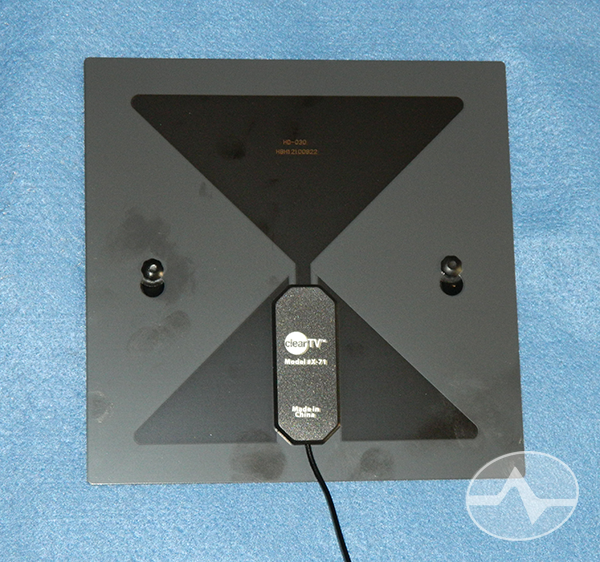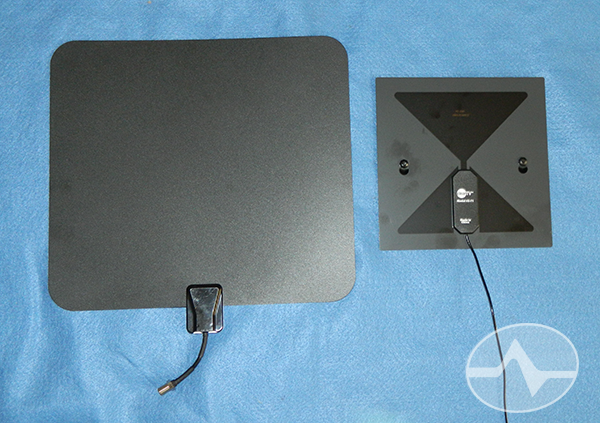When we tested the Mohu Curve against our HD-BLADE antenna we proved that our labs can do real side-by-side testing. Now, we’ve used exactly the same test parameters against another so-called contender, the Clear TV Antenna. This antenna is featured in late night infomercials.

This is the ClearTV antenna. We took advantage of the “Buy 1 get 1 free deal” but what we didn’t know is that we would be charged $16 shipping and handling, bringing the price for two antennas to $36.00. That’s still not a bad deal. However, the antennas took three weeks to arrive.
The antenna itself is really nothing more than a piece of circuit board with a balun glued to it. Two holes are placed in it and suction cups were provided. The suction cups were utterly useless; they wouldn’t stick to a piece of glass or a window. However, if you wanted to you could take the suction cups out of the holes and use command hooks or something.
It’s important to place the side of the antenna with the balun on it (the side shown here) toward the towers. The back side of the antenna seems to block all incoming signals.

The Clear TV antenna is quite a bit smaller than the HD-Blade as you can see here. That’s going to be a good thing if it actually performs. It was supplied with an attached thin cable similar to our Razor Thin Cable. It probably has fairly high loss but that’s not a huge concern at short distances.
One other thing to note is that the Clear TV antenna is a fingerprint magnet. We barely handled the antenna and you can see the fingerprint smudges. On the other hand this is our lab HD-BLADE and we never clean it or anything, and it still looks brand new a year later.
Testing parameters
In theory, the parameters shouldn’t matter as long as they are consistent but we’ll publish them here so you know that we were trying to be as scientific as possible.
All testing was conducted at our West Coast Operations Center outside of Los Angeles, California. Testing was conducted indoors with both antennas vertical at a height of one meter from the floor and pointing exactly toward Mt. Wilson where most LA area broadcast signals originate.
The test instrument was a Solid Signal DIGIAIR-PRO ATSC meter set to measure digital signals. With a 75 ohm terminator, the instrument measured 31.3dBμV (displayed on the instrument as dBuV) corresponding to -77.45dBm. This represents its lowest observable signal level.
The cable used for testing was a Solid Signal custom 3 foot RG6 cable with solid copper center conductor. It had previously been tested for continuity and signal and is believed to be representative of a typical well-made cable. The same cable was used for all testing.
The TV used for ATSC channel scans was the Insignia NS19E310A13.
The antennas tested were:
HD-BLADE Antenna from Solid Signal
Clear TV antenna
All testing took place during the same one-hour interval with sunny skies and no noticeable obstructions, at a distance of roughly 90km from Mt. Wilson, at an elevation of approximately 450m above sea level.
ATSC Channel scans
All three antennas were placed in the same position and a regular ATSC channel scan was run. Only digital channels were scanned. Channel number totals include subchannels.
HD-BLADE: 70 Digital Channels
Clear TV: 38 Digital Channels
The performance of the two antennas was really surprising until I started doing measurements with the meter.
Signal Meter test results

All observed measurements have been converted to dBm to correspond with TVFool.com’s benchmark readings for those frequencies. Any frequency measurements that were close to the meter’s lowest observable level of -77.45dBm were discarded.
The data confirmed the issue with the Clear TV antenna. The TV’s tuner was simply not able to pick up signals lower than -70dBm. Whenever one of the channels measured weaker than that on the meter, the TV itself wasn’t able to tune it with the Clear TV antenna. Interestingly it was able to tune channels that weak using the HD-BLADE. This suggests that the signal-to-noise ratio of the Clear TV antenna was making reception of those weak signals impossible.
| Frequency (MHz) | HD-BLADE | Clear TV | TVFool benchmark |
| 177 | -61.75 | -71.75 | -43 |
| 183 | -73.75 | -74.25 | -60.5 |
| 189 | -66.75 | -64.35 | -44.1 |
| 213 | -60.75 | -72.15 | -39.1 |
| 533 | -61.75 | -61.85 | -37.3 |
| 557 | -61.75 | -63.35 | -49.4 |
| 563 | -57.75 | -60.05 | -42 |
| 575 | -61.25 | -60.45 | -38 |
| 581 | -61.35 | -62.35 | -44.2 |
| 587 | -69.75 | -68.25 | -40.9 |
| 593 | -69.75 | -72.25 | -41.8 |
| 599 | -63.65 | -70.35 | -41.9 |
| 605 | -62.75 | -61.45 | -40.4 |
| 623 | -60.75 | -62.35 | -38.5 |
| 641 | -68.25 | -72.75 | -42.2 |
| 647 | -67.75 | -65.35 | -43.5 |
| 671 | -71.25 | -72.45 | -49.2 |
| 677 | -70.55 | -71.15 | -40.3 |
| 683 | -69.65 | -72.85 | -40 |
It’s no understatement that the Clear TV antenna disappointed us. We did expect the results to be a little more similar. The meter tests were close, even though the HD-BLADE outperformed the Clear TV in almost every case. The problem was that the Clear TV antenna just didn’t have what it took to bring in a good signal about half the time. Low gain combined with noise meant that the weak signals didn’t get to the TV.
If you are ten miles from the towers you might see reasonable results with the Clear TV antenna but that doesn’t mean a 100% satisfying experience. The price was low (although not as low as advertised) but what you get is a fingerprint magnet with two useless suction cups. The long shipping delay was also frustrating especially considering how much we paid for shipping and handling.
Advantage: Solid Signal
